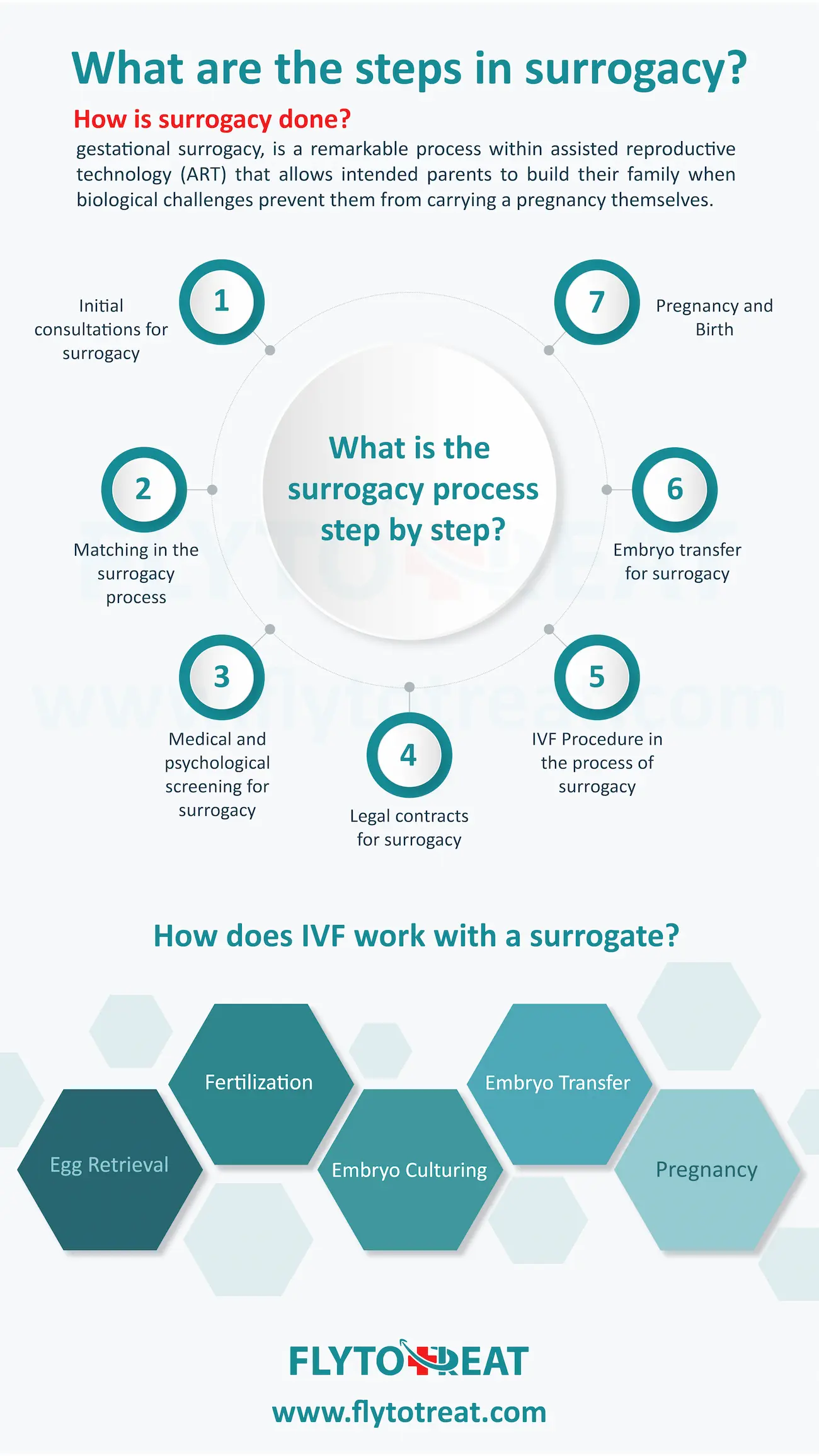
How is surrogacy done?
Understanding the Surrogacy process is essential for anyone considering this path to parenthood. This article will delve into various aspects of surrogacy, including detailed answers to questions like "how does surrogacy work?", "What is the surrogacy process step by step?", and "Can a fertilized egg be implanted in a surrogate?". FlyToTreat provides comprehensive support and information for intended parents and surrogates, ensuring that all participants are well-informed and prepared for each stage of this process.
How is surrogacy done?
Surrogacy, also known as gestational surrogacy, is a remarkable process within assisted reproductive technology (ART) that allows intended parents to build their family when biological challenges prevent them from carrying a pregnancy themselves. In the Surrogacy process, a compassionate woman, the gestational carrier, agrees to carry the intended parents' embryo in her womb until birth. The gestational carrier has no genetic connection to the baby, and after delivery, fully legal and parental rights are established for the intended parents.
To see different surrogacy types, check out the link.
Surrogacy offers hope and the possibility of parenthood for many intended parents. If you're considering this path, researching what is the surrogacy process and consulting with a qualified healthcare professional at FlytoTreat can be the first steps on your journey. Here’s how does a woman get pregnant with surrogacy.

What is the surrogacy process step by step?
Process of surrogacy involves several steps to ensure the successful birth of a child. Here's an overview of what is the gestational carrier process:
1. How do Initial Consultations for surrogacy go on? Starting the surrogacy process, the intended parents meet with a surrogacy agency or clinic to discuss their needs and the specifics of the gestational surrogacy process.
2. What is Matching In the surrogacy process? A surrogate mother is selected and matched with the intended parents based on mutual preferences and medical compatibility.
3. Medical and Psychological Screening for surrogacy? The surrogate undergoes thorough medical and psychological evaluations to ensure she is fit for the surrogacy process.
4. What are legal contracts for surrogacy? Both parties sign legal agreements outlining the responsibilities and rights of the surrogate and intended parents.
5. How is IVF Procedure in the process of surrogacy? The IVF surrogacy process begins with the collection of eggs from the intended mother or an egg donor, which are then fertilized with the sperm of the intended father or a sperm donor. We will delve into this in the next section.
6. What is embryo transfer for surrogacy? The resulting embryo is implanted into the surrogate’s uterus through in vitro fertilization (IVF).
7. When the Pregnancy and Birth happen? The surrogate carries the baby to term and, upon birth, the child is handed over to the intended parents.
How does IVF work with a surrogate?
Wondering How do you create an embryo for surrogacy? The answer is IVF surrogacy process. It involves several critical steps to ensure the successful implantation and pregnancy of the surrogate. Here’s a brief overview:
• Egg Retrieval: The intended mother or an egg donor undergoes ovarian stimulation to produce multiple eggs, which are then retrieved.
• Fertilization: The eggs are fertilized with sperm from the intended father or a sperm donor in a laboratory setting, creating embryos.
• Embryo Culturing: The embryos are cultured for a few days to ensure they develop properly.
• Embryo Transfer: A selected embryo is transferred into the surrogate’s uterus.
• Pregnancy: The surrogate carries the pregnancy to term, delivering the baby for the intended parents.
This surrogacy with the IVF process ensures that the child has a genetic connection to the intended parents, even though the surrogate is not biologically related to the baby.
What are the injections for IVF surrogacy?
In the surrogacy with IVF process, specific medications are crucial for preparing the surrogate's body to receive and nurture the embryo. Surrogates often begin with estrogen patches or pills to thicken the uterine lining, creating an optimal environment for implantation. Progesterone in oil injections is also essential, as it supports the uterine lining and maintains pregnancy. Additionally, surrogates may take antibiotics to prevent infections and other medications to suppress their natural menstrual cycle. These medications are meticulously timed to synchronize the surrogate’s cycle with the embryo transfer, ensuring the best possible outcome for the pregnancy. Understanding the gestational surrogacy process involves recognizing the importance of these medications, which play a vital role in the success of the IVF surrogacy process, ensuring the surrogate’s body is fully prepared for the path ahead.
What is the difference between IVF and IVF surrogacy?
The primary difference between IVF and IVF + surrogacy lies in who carries the pregnancy. In standard IVF, the intended mother undergoes ovarian stimulation to produce eggs, which are then fertilized with sperm to create embryos. One or more embryos are transferred to her uterus, where she carries the pregnancy. In contrast, the IVF surrogacy process involves a surrogate mother carrying the pregnancy. The intended mother's eggs (or donor eggs) are fertilized, and the resulting embryo is implanted into the surrogate's uterus. This procedure of surrogacy is often chosen when the intended mother cannot carry a pregnancy due to health issues or previous medical conditions. Understanding what is surrogacy process helps clarify that while both methods use IVF technology, the key distinction is the role of the surrogate in carrying the baby.
How do they implant an embryo into a surrogate?
In the surrogacy with IVF process, inculcate an embryo into a surrogate's uterus contains a handful of heedful steps. First, the surrogate goes through hormone treatments to make her uterus ready, guaranteeing it is acceptant to the embryo. During the IVF surrogacy process, the embryo, created through fertilization of the intended mother's (or donor's) egg with the intended father's (or donor's) sperm, is carefully placed into the surrogate's uterus using a thin catheter. This procedure benefits from ultrasound guidance to guarantee accurate placement.The surrogate then rests to allow the embryo to implant and begin developing. This part of the gestational surrogacy process is critical, as proper implantation is crucial for a successful pregnancy. Understanding what is surrogacy process helps clarify how medical professionals work meticulously to optimize conditions for the embryo's growth and the surrogate’s health. This answers the question, Can a fertilized egg be implanted in a surrogate?
Conclusion
In conclusion, the surrogacy process, particularly when combined with IVF, offers a viable path to parenthood for those facing biological challenges. From the initial consultations and medical screenings to the precise embryo transfer and supportive medications, each step is carefully designed to ensure success. By understanding these detailed procedures and collaborating with experienced professionals at FlyToTreat, intended parents can navigate this complex journey with confidence, ultimately achieving their dream of starting or growing their family.
MEDICALLY REVIEWED BY: Dr. Ali Bazazi
AUTHOR: FlytoTreat's team of Authors
23 July 2024 - Updated At: 15 October 2024
Related Articles
Comment




